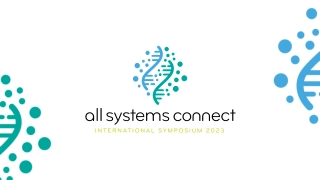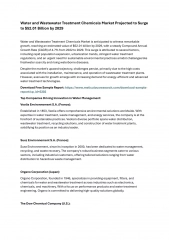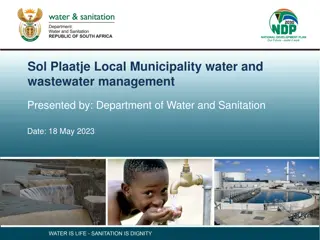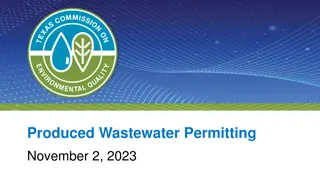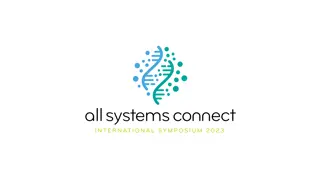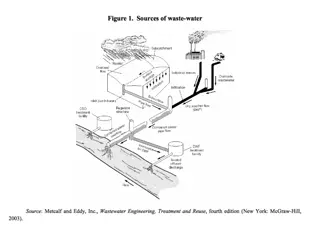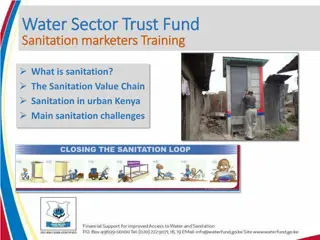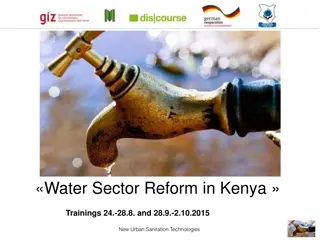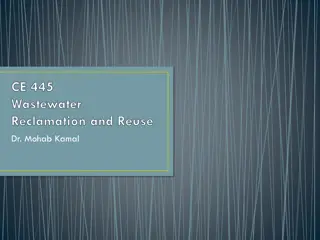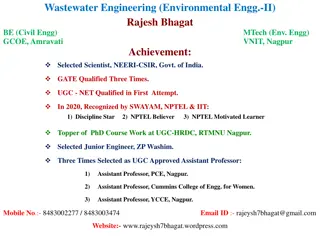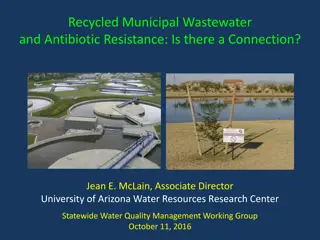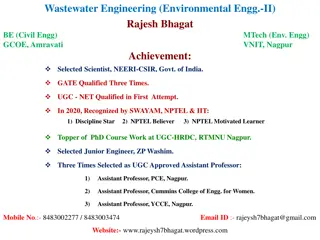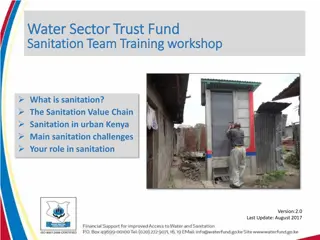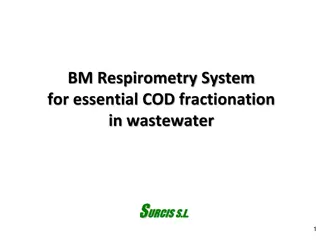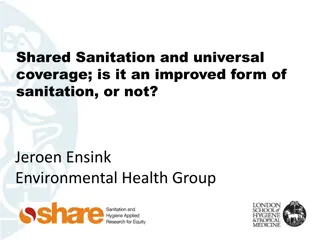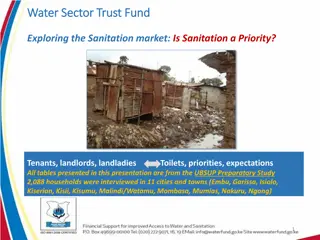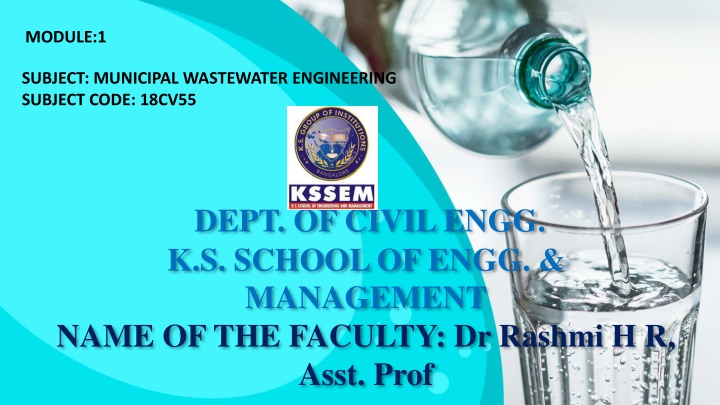
Municipal Wastewater Engineering - Need for Sanitation Methods
Proper disposal of human excreta and wastewater is crucial to prevent insanitary conditions and pollution of land or water bodies. Explore the methods of sewage disposal and understand the advantages and disadvantages of conservancy and water carriage systems.
Download Presentation

Please find below an Image/Link to download the presentation.
The content on the website is provided AS IS for your information and personal use only. It may not be sold, licensed, or shared on other websites without obtaining consent from the author. If you encounter any issues during the download, it is possible that the publisher has removed the file from their server.
You are allowed to download the files provided on this website for personal or commercial use, subject to the condition that they are used lawfully. All files are the property of their respective owners.
The content on the website is provided AS IS for your information and personal use only. It may not be sold, licensed, or shared on other websites without obtaining consent from the author.
E N D
Presentation Transcript
MODULE:1 SUBJECT: MUNICIPAL WASTEWATER ENGINEERING SUBJECT CODE: 18CV55 DEPT. OF CIVIL ENGG. K.S. SCHOOL OF ENGG. & MANAGEMENT NAME OF THE FACULTY: Dr Rashmi H R, Asst. Prof
TOPICS NEED FOR SANITATION METHODS FOR SEWAGE DISPOSAL TYPES OF SEWAGE SYSTEM DRY WEATHER FLOW WET WEATHER FLOW FACTOR AFFECTING DRY WEATHER FLOW AND WET WEATHER FLOW
NEED FOR SANITATION Proper disposal of human excreta to safe place before it starts decomposing and cause insanitary conditions. To take out all kinds of wastewater immediately ,so that mosquitos , bacteria etc , should not breed in it. Final disposal of sewage on land or in nearby waterbodies should be treated , so that receiving land or water may not get polluted for further use.
METHODS OF SEWAGE DISPOSAL There are two types of methods of sewage disposal are; 1] CONSERVANCY SYSTEM 2] WATER CARRIAGE SYSTEM
CONSERVANCY SYSTEM In this system types of refuse and storm water is collected , conveyed and disposed separately by various methods . This method was in practice in ancient times . In present also this method is in practice in small towns , villages etc ..
ADVANTAGES OF CONSERVANCY SYSTEM Initial cost is low . The quality of sewage reaching at the treatment before disposal is low . DISADVANTAGES OF CONSERVANCY SYSTEM Possibility of storm water may mix with sewers and cause heavy load on treatment plant . In crowded lanes it is difficult to provide two different sewers . Decomposition of sewage may cause insanitary conditions and dangerous for human health .
WATER CARRIAGE SYSTEM In this system , the excremental matters are mixed up in large quantity of water and are taken out of the city through proper drainage system and disposed off after necessary treatment . The sewage consists of 99.9% of water and 0.1% of solids. This system is universally used now a days .
ADVANTAGES OF WATER CARRIAGE SYSTEM It is hygienic method because all excremental matters are collected and disposed by water. Less space is occupied as only one sewer is laid . The land required for disposal work is less as compared to conservancy system . DISADVANTAGES OF WATER CARRIAGE SYSTEM This system is very costly in initial cost. The maintainance of system also very costly .
TYPES OF SEWER SYSTEM Separate system Combined system Partially separate system
SEPARATE SEWER SYSTEM In this system two sets of sewers are laid for drainage and sewage. Drainage and sewage are taken independently of each other through these two different sets of conduits. The sewage is carried to the treatment plant and storm water is disposal of to water
COMBINED SYSTEM In this system only one set of sewers are used to carry both sanitary sewage and surface water. Sewage and storm water both are carried to the treatment plant through combined sewers.
PARTIALLY SEPARATE SYSTEM A portion of storm water during rain such that the water originating from roof tops and paved courtyards is allowed to enter sanitary sewer to treatment plants. Thus by diluting the waste concentration
DRY WEATHER FLOW It is the quantity of water that flows through a sewer in dry weather when no storm water is in the sewer. It is also known as sanitary sewage.
SOURCES Domestic waste water: the waste water reaching sewer due to domestic activities such as bathing, washing clothes and vessels etc. Industrial waste water: the waste water generated due to manufacturing process in industries . Waste water from public facilities: that is the waste water generated from school, cinemas , hotels etc. ground water infiltration: infiltration of gw depends upon the nature of soil, materials of sewer, nature and condition of sewer joints, depth of sewer
WET WEATHER FLOW The amount of rain water flowing over the ground surface, pavements , house roofs etc..,is commonly known as runoff or storm water. this storm water is ultimately drained through the sewer ;the amount of peak storm water flow is several times more than of DWF. This storm water flow is also known as wet weather flow
FACTOR AFFECTING THROUGH DWF Rate of water supply: the quantity of used water discharged into sewer system is little less than the amount of water supplied to community. Population growth: the quantity of sanitary sewage directly depends on the population . Type of area served: if the area served is residential, the waste water produced is assumed to be equal to 70 % to 80 % Infiltration of ground water: infiltration of water into sewer through joints increases the quantity of sewage
FACTOR AFFECTING THROUGH WWF Catchment area Ground slope Permeability of ground Extent of vegetation growth Rainfall intensity Rainfall duration Condition of ground prior to rainfall Concentration of catchment area Climatic condition such as wind, temperature , humidity etc..,
Useful link https://www.youtube.com/watch?v=YegffvYy8OY&lis t=PLq46p_ppqQemlLzkiMgKtPkkLWOKgN1kT https://www.youtube.com/watch?v=zVZ9c6EXfTA https://www.youtube.com/watch?v=We9BvA814gk

